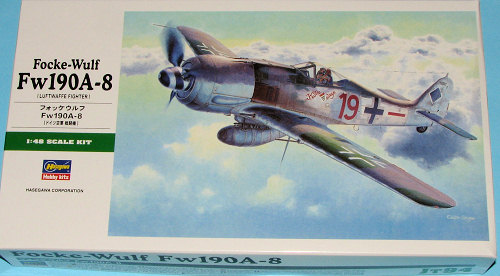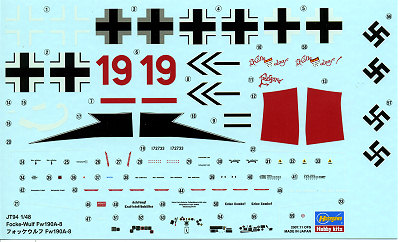
Hasegawa 1/48 FW-190A-8
| KIT: | Hasegawa 1/48 FW-190A-8 |
| KIT #: | 09094 (Jt 94) |
| PRICE: | $ |
| DECALS: | Two options |
| REVIEWER: | Scott Van Aken |
| NOTES: |

| HISTORY |
The FW-190A-8 was the penultimate radial engine 190 version, (the last production A model was the up-engined A-9). It was probably the most widely used version of the last months of the war, though by then there was little it or any other weapons system could really due to stem the tide of Allied advances.
The A-8 version was basically an updated A-7. The A-7 variant brought into production the replacement of the 7.92mm cowl machine guns with 13.3 mm versions, a distinguishing feature of the version. However, fewer than 100 were built before moving on to the most produced variant, the A-8 with about 1,300 completed before war's end. There were a myriad of 'options' that could be attached to the A-8 air frame in terms of weapons and armor. Suffice it to say, it was a very nice handling aircraft and thanks to its roomier cockpit and wider tracked landing gear, often preferred over the later model 109s.
| THE KIT |
 This
is a continuation of the various FW-190A kits that have been produced by
Hasegawa. Interestingly they have followed a logical progression of versions for
their kit releases, the last one being the A-5 version with the BMW car from
last year. This one brings us up to the FW-190A-8 version as flown by many of
the Luftwaffe's ace pilots.
This
is a continuation of the various FW-190A kits that have been produced by
Hasegawa. Interestingly they have followed a logical progression of versions for
their kit releases, the last one being the A-5 version with the BMW car from
last year. This one brings us up to the FW-190A-8 version as flown by many of
the Luftwaffe's ace pilots.
There is little that is much different from the A-5 version aside from those bits needed to make the A-8. This includes a new upper cowling with the bulges to accommodate the larger guns, lower wing antenna and a few other pieces. A new 'blown' canopy is in with the kit, but not used on either markings variant. Likewise there is another set of lower gun access panels with extended shell chutes that is not used. Same goes for a bomb and wing racks.
Some very minor surgery and hole opening will be needed
on this one and in line with others in
 this series, the five piece
cowling will need care in assembly. Two drop tank rack options are given, one
being a larger version of the other. One of the bug-a-boos of 190 kits is the
prop and while I can't say for sure, this one does very much look the part.
this series, the five piece
cowling will need care in assembly. Two drop tank rack options are given, one
being a larger version of the other. One of the bug-a-boos of 190 kits is the
prop and while I can't say for sure, this one does very much look the part.
Instructions are the usual well done versions with Gunze references. I also noticed several small drawings to help with alignment and getting parts installed properly where they might be reversed. A nice touch. Markings are for two aircraft. The box art plane from JG 300 provides two options, one having more fuselage mottling and a red fuselage band. The other is from JG 2 as flown by Kurt Buhligen in June 1944. This one has a hard edged splinter pattern of RLM 71 or 74 and RLM 02 over RLM 76. A yellow lower cowling. The previous aircraft is in standard RLM 74/75/76. Decals are well printed and provide instrument and side console decals in case you don't want to paint the nicely done raised detailing provided on the kit parts. My experience shows that with care, the decals will fit right over the panel details.
| CONCLUSIONS |
So you can now add Hasegawa to the list of Otaki, Tamiya, Dragon, and Eduard who produce nice 190A-8 kits. As to which is the best, well, I'm embarrassed to say that I've not built any of these in the A-8 version aside from the Dragon kit. The Hasegawa version certainly looks to be well done and if it is like the 190A-3 I did several years ago, it will make into a beauty.
January 2008
My thanks to www.dragonmodelsusa.com for the review sample. Get yours at your local hobby shop or ask them to order it for you.
If you would like your product reviewed fairly and quickly, please contact me or see other details in the Note to Contributors.